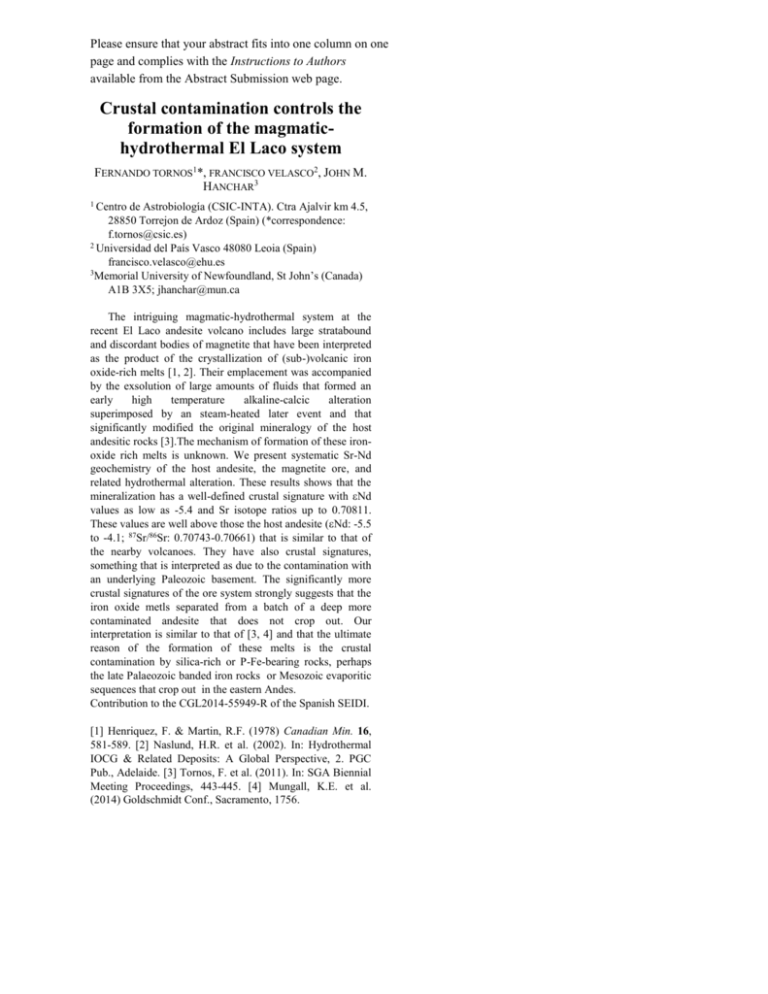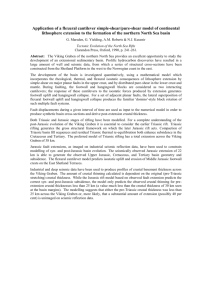presentation file
advertisement

Please ensure that your abstract fits into one column on one page and complies with the Instructions to Authors available from the Abstract Submission web page. Crustal contamination controls the formation of the magmatichydrothermal El Laco system FERNANDO TORNOS1*, FRANCISCO VELASCO2, JOHN M. HANCHAR3 1 Centro de Astrobiología (CSIC-INTA). Ctra Ajalvir km 4.5, 28850 Torrejon de Ardoz (Spain) (*correspondence: f.tornos@csic.es) 2 Universidad del País Vasco 48080 Leoia (Spain) francisco.velasco@ehu.es 3Memorial University of Newfoundland, St John’s (Canada) A1B 3X5; jhanchar@mun.ca The intriguing magmatic-hydrothermal system at the recent El Laco andesite volcano includes large stratabound and discordant bodies of magnetite that have been interpreted as the product of the crystallization of (sub-)volcanic iron oxide-rich melts [1, 2]. Their emplacement was accompanied by the exsolution of large amounts of fluids that formed an early high temperature alkaline-calcic alteration superimposed by an steam-heated later event and that significantly modified the original mineralogy of the host andesitic rocks [3].The mechanism of formation of these ironoxide rich melts is unknown. We present systematic Sr-Nd geochemistry of the host andesite, the magnetite ore, and related hydrothermal alteration. These results shows that the mineralization has a well-defined crustal signature with Nd values as low as -5.4 and Sr isotope ratios up to 0.70811. These values are well above those the host andesite (Nd: -5.5 to -4.1; 87Sr/86Sr: 0.70743-0.70661) that is similar to that of the nearby volcanoes. They have also crustal signatures, something that is interpreted as due to the contamination with an underlying Paleozoic basement. The significantly more crustal signatures of the ore system strongly suggests that the iron oxide metls separated from a batch of a deep more contaminated andesite that does not crop out. Our interpretation is similar to that of [3, 4] and that the ultimate reason of the formation of these melts is the crustal contamination by silica-rich or P-Fe-bearing rocks, perhaps the late Palaeozoic banded iron rocks or Mesozoic evaporitic sequences that crop out in the eastern Andes. Contribution to the CGL2014-55949-R of the Spanish SEIDI. [1] Henriquez, F. & Martin, R.F. (1978) Canadian Min. 16, 581-589. [2] Naslund, H.R. et al. (2002). In: Hydrothermal IOCG & Related Deposits: A Global Perspective, 2. PGC Pub., Adelaide. [3] Tornos, F. et al. (2011). In: SGA Biennial Meeting Proceedings, 443-445. [4] Mungall, K.E. et al. (2014) Goldschmidt Conf., Sacramento, 1756.











